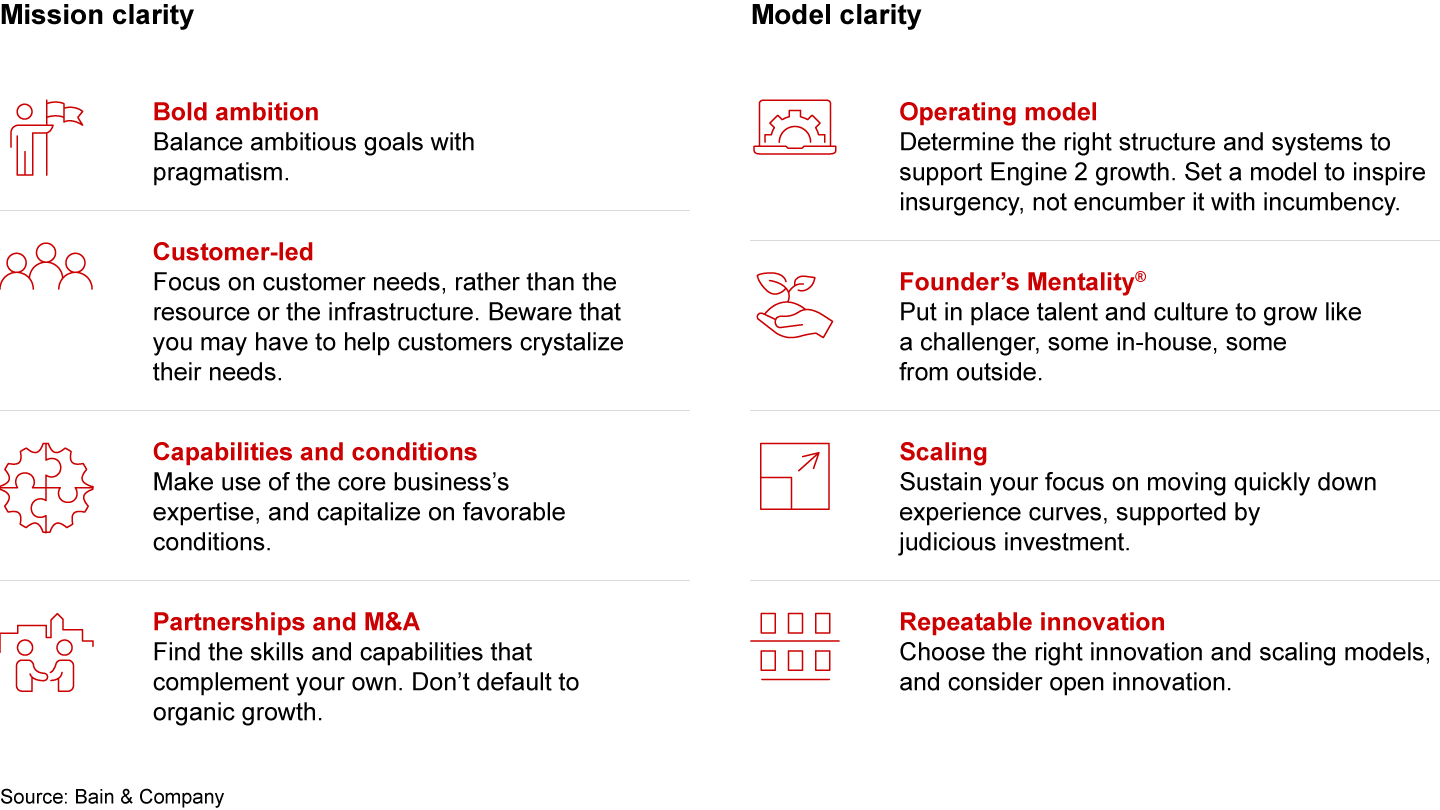Energy & Natural Resources Report
 }
}
概要
- Energy and natural resources companies are ramping up spending in new growth businesses to complement or replace their core.
- Success depends on mission clarity, a bold vision that pragmatically lays out the objective.
- Model clarity is essential, too, defining how a new entrepreneurial venture can thrive alongside the legacy business.
This article is part of Bain’s Energy and Natural Resources Report 2022
Few sectors have ever had to change as quickly and completely as the energy and natural resources (ENR) sectors are changing now.
Executives know they need to develop new growth businesses that are in some cases very different from their core. Most have already moved past talk: We found that ENR companies increased the capital allocated to growing new businesses by about 50%, on average, from 2020 to 2022—a huge jump.
Senior leaders expect to see results quickly from such a large investment: 72% told us they expect to move these investments to scale by 2030—not far away.
Challenge acknowledged, goals set, capital allocated. Now comes the hard part. How do they grow these new businesses, which we call Engine 2? What are the preconditions for executing successfully?
Essential clarity on mission and model
For most ENR sectors, there’s a limited set of promising growth opportunities that make good use of the incumbents’ capabilities and offer a compelling story for investors. As a result, many ENR companies are pursuing the same Engine 2 growth areas. They can’t all win in the same space. It’s OK to have an Engine 2 mission that overlaps with others’, but it’s not OK to lack clarity on what your mission is.
Mission clarity. Mission clarity starts with a bold objective. No one gains a leading position in a new profit pool by dipping their toe in the water. Still, the mission needs to be pragmatic and strike a balance between being bold enough to change the world’s energy infrastructure, while not spending capital imprudently.
Mission clarity is also not as simple as just choosing green hydrogen, sustainable agriculture, or carbon offsets. The mission must include a clear sense of which customer needs you’re addressing, whether you have the capabilities to achieve it, or whether you’ll need to find those through M&A and partnerships.
Model clarity. Traditional energy and resource companies, the incumbents, usually move at a slower pace than their start-up competitors. That’s part legacy infrastructure and operations, and part company culture.
Successful Engine 2 efforts play by a different set of rules. They find ways to operate in a middle zone, taking advantage of all the benefits of a large company (access to capital, deep experience, large networks of suppliers and customers) while steering clear of the drawbacks (excessive caution, bureaucratic bottlenecks, a wait-and-see attitude).
To make this happen, Engine 2 initiatives need to design for growth from the start.
One of the elements we see ENR incumbents struggle with most is what we call the Founder’s Mentality®. This means setting up a team that can act like insurgents, not incumbents, and clearing the way so that they can do that.
Some companies have found ways to launch Engine 2s where mission and model clarity work well together. For example, Italian energy provider Enel set a bold vision to replace its core business. It approached several new markets with a mindset of “why not us?” and found customers as it developed its Engine 2 capabilities in hydroelectric, onshore wind, and solar power. Enel’s leadership combined all its renewable assets into one business unit, along with the people who knew them best. That allowed Enel Green Power to start with a sizable base of about $1 billion in earnings, going from 4.5 gigawatts of installed capacity in 2008 to more than 50 gigawatts by 2021. The company has maintained its bold ambition and plans to dedicate 43% of capex to affordable and clean energy, adding 105 gigawatts of renewables capacity by 2030.
In another example, Australian iron ore producer Fortescue has set out to become a leading player in green hydrogen, aiming to produce 15 million tons by 2030. Fortescue Future Industries (FFI), a distinct entity in the company, is building collaborative relationships around new hydrogen projects, including an electrolyzer manufacturing plant in Queensland, Australia, which will provide green hydrogen to power a manufacturing hub. FFI moves rapidly while benefiting from the parent company’s cash flow and relationships.
Building mission and model clarity
Among the companies that we see successfully executing Engine 2 strategies, mission and model clarity lead to better decision making on a range of factors that influence success (see Figure 1).

Many great ENR companies started out as insurgents. All great ENR companies have had to evolve with cycles and technology. The successful ones grew large and evolved their operating models to manage scale operations that often span the globe and a wide range of businesses. Developing Engine 2 initiatives offers incumbents the chance to ignite an entrepreneurial spirit in their DNA, in order to develop new growth businesses that will lead them to thrive in the energy transition.
Founder’s Mentality® is a registered trademark of Bain & Company, Inc.
